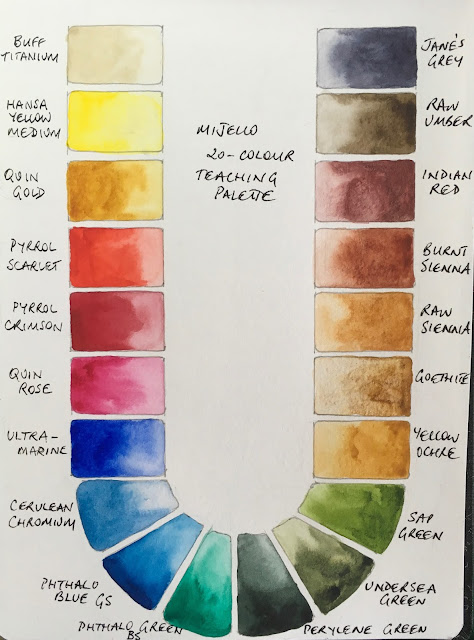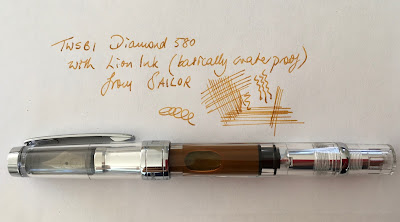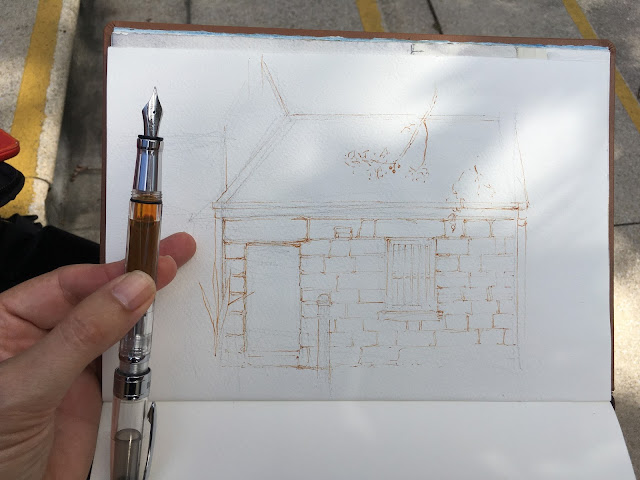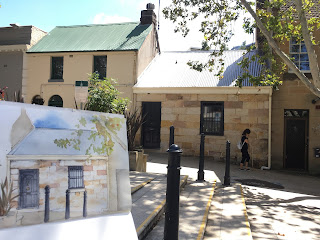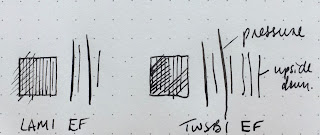 |
| Isaro Watercolour 7ml tubes |
July 2020: They are now also available in Australia here.
The website states that "The entire range of Isaro water colours has been developed to give maximum transparency to the colours. In addition, the ingredients that enter the composition of the binder are all carefully selected. Only top quality gum Arabic is used in the manufacture of Isaro water colours. Gum arabic varies in colour from very pale yellow to dark brown. The gum, in fact, darkens on contact with the tennis in the acacia bark. Consequently, it is essential for Isaro to select an acacia gum which, when dissolved in water, gives a clear solution to that the luminosity of the pigments is protected. Glycerine and honey are added in very precise proportions to ensure the paste remains supple. A single-flower honey was chosen, the honey of the acacia, since good quality honey of this type is very clear."
I received samples of nearly all the colours and really enjoyed painting them out. The cadmiums seem very finely ground and not as opaque or heavy as they can be. Some names were different on the colour chart and the website so I will note both in the captions. The dried dots of colour mostly rewet with ease. They are available in 7ml and some in 20ml tubes. The 7ml tubes feel robust with a solid lid.
It is a really nicely balanced range of just over 50 colours, plus some metallic colours, with a good mix of traditional and modern pigments. I didn't notice any pigments that are not lightfast. The tubes are well labelled with series number, lightfast stars, opacity guide and pigment information. The majority are single pigment colours but there are some useful mixes.
I like PY154 for the mid or primary yellow, with Indian yellow as the warm option, though it's a shame it isn't a single pigment colour.
 |
| Isaro Watercolours - Titanium White (not shown), Cadmium Yellow Lemon, Isaro Yellow Light (also called Isaro Yellow), Cadmium Yellow Light, Cadmium Yellow Deep. |
 |
| Isaro Watercolours - Indian Yellow, Isaro Yellow Deep, Cadmium Orange, Pyrrol Orange, Cadmium Red Light. |
I love PR255 Scarlet Red (also called Pyrrole Red on the website - Pyrrole Scarlet would be a great name for this colour) as a warm red in a transparent split primary palette. The cool would be Magenta in this range, with Pyrrole Red Deep as the optional third Crimson red - so useful for mixing.
 |
| Isaro Watercolours - Scarlet Red (also called Pyrrol Red. Pyrrol Scarlet would be a great name for this one), Isaro Pyrrole Red, Pyrrole Red Deep, Cadmium Red Deep, Perylene Red. |
Magenta is the usual Quinqacridone Rose/Permanent Rose colour, while Isaro Pink is the normal Quiacridone Magenta colour. Isaro Mauve is Quinacridone Violet in most ranges. Isaro Purple Deep is Dioxozine Violet.
 |
| Isaro Watercolours - Magenta, Isaro Pink (Also called Isaro Rose), Ultramarine Pink (also called Ultramarine Rose), Isaro Mauve, Isaro Purple Deep (also called Isaro Mauve Deep). |
The Ultramarine Violet is a particularly nice version of this often weak pigment. I like this version of a PB35 Cerulean too - a useful non-staining cool blue colour. Ultramarine is the classic warm blue - it's hard to set up a watercolour palette without it.
 |
| Isaro Watercolours - Ultrmarine Violet, Ultramarine, Indanthrone Blue, Cobalt Blue, Cerulean Blue. |
Indigo Blue is made with two blues and a brown pigment rather than the usual black and blue mix, which is great to see. As far as I know, Schmincke and Da Vinci are the only other manufacturers to make an Indigo hue without black. There are no cobalt turquoise colours (PB36) in the range.
 |
| Isaro Watercolours - Indigo blue, Prussian Blue, Phthalo Blue, Turquoise Green (not shown), Phthalo Green. |
Emerald Green is Viridian - often not a strong pigment. The Isaro Grey Light is an interesting soft convenience grey.
 |
| Isaro Watercolours - Emerald Green, Phthalo Green Yellow, Chromium Oxide Green, Olive Green (not shown but this is the new formula), Isaro Grey Light. |
Chartreuse Yellow is often called Green Gold - a wonderful pigment for the look of sunlight through foliage, or as a cool yellow option. The Yellow Ochre says it is made from PY42 on the colour chart but PY43 on the website. I am not sure which is correct, but it's a lovely version of this colour. Oxide Orange is the most orange version I have ever seen of a PR101 colour - really lovely.
 |
| Isaro Watercolours - Isaro Green LIght (not shown), Chartreuse Yellow, Yellow Ochre, Raw Sienna, Oxide Orange. |
 |
| Isaro Watercolours - Burnt Sienna, Mars Red, Mars Brown Light, English Red (not shown), Venetian Red. |
Raw Umber was not as strong is I'd like. The Sepa and Van Dijck Brown are really dark versions of these hues.
 |
| Isaro Watercolours - Oxide Purple, Burnt Umber (not shown), Raw Umber, Sepia, Van Dijck Brown. |
There are a number of 'Metallic Touch' watercolours that contain mica or copper. It is difficult to show sparkle but I have included these after the Lamp Black swatch. Steel Blue is a bit like my Jane's Grey but with mica added.
 |
| Isaro Watercolours - Payne's Grey, Lamp Black, Steel Blue, Icy Lake, Imperial Moon. |
'Or' (Gold) is included on the website but not in the colour chart, so I created a swatch for that. I also created a swatch for Nickel Yellow as it was on the colour chart but as it is not on the website I assume it has been discontinued. It is not a very strong pigment in any brand so that's not surprising.
 |
| Isaro Watercolours - Silver Sky, Eternal Summit, Star Dust, Coppery Red (not shown), Gold (not shown), Nickel Yellow (not shown and probably discontinued.) |
2022: the range has grown and you can now purchase these 75+ colours from Jacksons in the UK. Here is the full current range (affiliate link).


